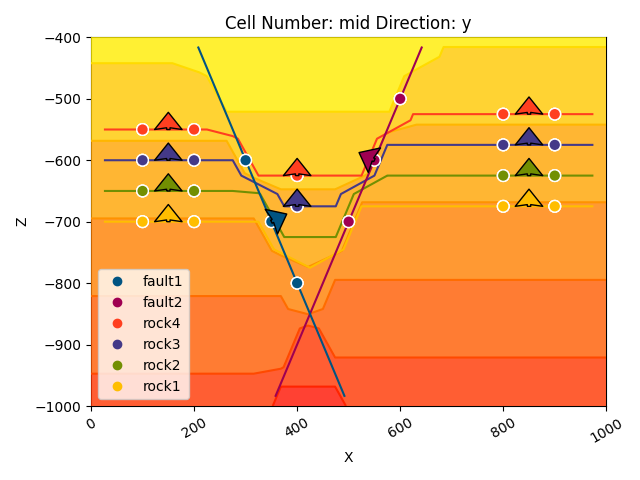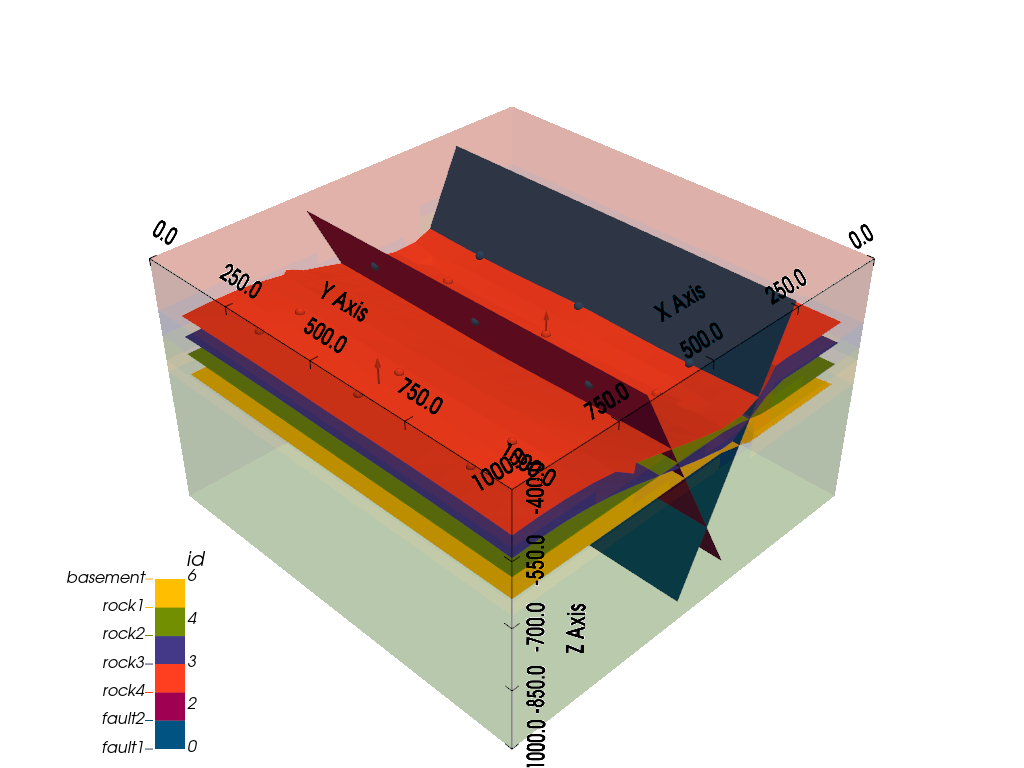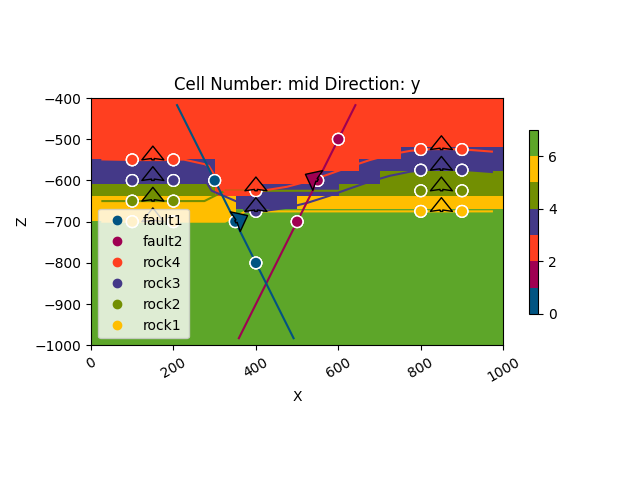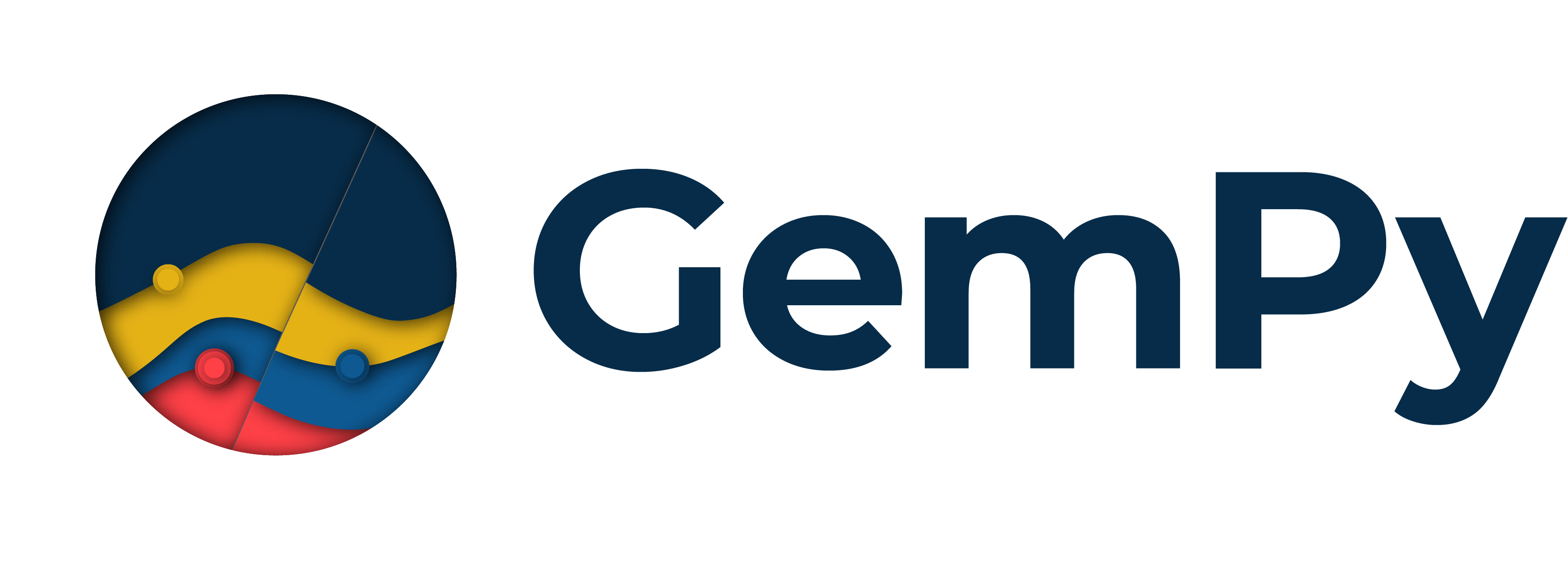Note
Go to the end to download the full example code.
1.5: Fault relations¶
Importing gempy
import gempy as gp
import gempy_viewer as gpv
# Aux imports
import numpy as np
import os
np.random.seed(1515)
We import a model from an existing folder.
data_path = os.path.abspath('../../')
geo_model: gp.data.GeoModel = gp.create_geomodel(
project_name='Faults_relations',
extent=[0, 1000, 0, 1000, -1000, -400],
resolution=[20, 20, 20],
refinement=6, # * For this model is better not to use octrees because we want to see what is happening in the scalar fields
importer_helper=gp.data.ImporterHelper(
path_to_orientations=data_path + "/data/input_data/tut-ch1-5/tut_ch1-5_orientations.csv",
path_to_surface_points=data_path + "/data/input_data/tut-ch1-5/tut_ch1-5_points.csv",
)
)
print(geo_model)
meta=GeoModelMeta(name='Faults_relations', creation_date='2025-05-21T11:32:27.213985', last_modification_date=None, owner=None) structural_frame=StructuralFrame(
structural_groups=[
StructuralGroup(
name=default_formation,
structural_relation=StackRelationType.ERODE,
elements=[
Element(
name=fault1,
color=#015482,
is_active=True
),
Element(
name=fault2,
color=#9f0052,
is_active=True
),
Element(
name=rock1,
color=#ffbe00,
is_active=True
),
Element(
name=rock2,
color=#728f02,
is_active=True
),
Element(
name=rock3,
color=#443988,
is_active=True
),
Element(
name=rock4,
color=#ff3f20,
is_active=True
)
]
)
],
fault_relations=
[[False]],
grid=Grid(values=array([[ 25., 25., -985.],
[ 25., 25., -955.],
[ 25., 25., -925.],
...,
[ 975., 975., -475.],
[ 975., 975., -445.],
[ 975., 975., -415.]], shape=(8000, 3)), length=array([], dtype=float64), _octree_grid=None, _dense_grid=RegularGrid(resolution=array([20, 20, 20]), extent=array([ 0., 1000., 0., 1000., -1000., -400.]), values=array([[ 25., 25., -985.],
[ 25., 25., -955.],
[ 25., 25., -925.],
...,
[ 975., 975., -475.],
[ 975., 975., -445.],
[ 975., 975., -415.]], shape=(8000, 3)), mask_topo=array([], shape=(0, 3), dtype=bool), _transform=None), _custom_grid=None, _topography=None, _sections=None, _centered_grid=None, _transform=None, _octree_levels=-1) geophysics_input=None input_transform={'_cached_pivot': None,
'_is_default_transform': False,
'position': array([-500., -500., 650.]),
'rotation': array([0., 0., 0.]),
'scale': array([0.000625, 0.000625, 0.000625])} interpolation_grid=None interpolation_options=InterpolationOptions(kernel_options=KernelOptions(range=1.7, c_o=10.0, uni_degree=1, i_res=4.0, gi_res=2.0, number_dimensions=3, kernel_function=AvailableKernelFunctions.cubic, kernel_solver=Solvers.DEFAULT, compute_condition_number=False, optimizing_condition_number=False, condition_number=None), evaluation_options=EvaluationOptions(_number_octree_levels=6, _number_octree_levels_surface=4, octree_curvature_threshold=-1.0, octree_error_threshold=1.0, octree_min_level=2, mesh_extraction=True, mesh_extraction_masking_options=<MeshExtractionMaskingOptions.INTERSECT: 3>, mesh_extraction_fancy=True, evaluation_chunk_size=500000, compute_scalar_gradient=False, verbose=False), debug=True, cache_mode=<CacheMode.IN_MEMORY_CACHE: 3>, cache_model_name='Faults_relations', block_solutions_type=<BlockSolutionType.DENSE_GRID: 2>, sigmoid_slope=5000000, debug_water_tight=False, temp_interpolation_values=TempInterpolationValues(current_octree_level=0))
One fault model¶
Setting the structural frame
fault1: gp.data.StructuralElement = geo_model.structural_frame.get_element_by_name("fault1")
fault2: gp.data.StructuralElement = geo_model.structural_frame.get_element_by_name("fault2")
# Remove the faults from the default group
default_group: gp.data.StructuralGroup = geo_model.structural_frame.get_group_by_name("default_formation")
default_group.elements.remove(fault1)
default_group.elements.remove(fault2)
# Add a new group for the fault
gp.add_structural_group(
model=geo_model,
group_index=0,
structural_group_name="fault_series_1",
elements=[fault1],
structural_relation=gp.data.StackRelationType.FAULT,
fault_relations=gp.data.FaultsRelationSpecialCase.OFFSET_ALL
)
print(geo_model.structural_frame)
StructuralFrame(
structural_groups=[
StructuralGroup(
name=fault_series_1,
structural_relation=StackRelationType.FAULT,
elements=[
Element(
name=fault1,
color=#015482,
is_active=True
)
]
),
StructuralGroup(
name=default_formation,
structural_relation=StackRelationType.ERODE,
elements=[
Element(
name=rock1,
color=#ffbe00,
is_active=True
),
Element(
name=rock2,
color=#728f02,
is_active=True
),
Element(
name=rock3,
color=#443988,
is_active=True
),
Element(
name=rock4,
color=#ff3f20,
is_active=True
)
]
)
],
fault_relations=
[[False, True],
[False, False]],
geo_model.input_transform.apply_anisotropy(gp.data.GlobalAnisotropy.NONE)
gp.compute_model(geo_model)
Setting Backend To: AvailableBackends.numpy
/home/leguark/TeamCity/work/3a8738c25f60c3c9/venv/lib/python3.10/site-packages/gempy_engine/modules/activator/_soft_segment.py:95: RuntimeWarning: overflow encountered in exp
return 1.0 / (1.0 + bt.t.exp(x))
Chunking done: 6 chunks
Chunking done: 31 chunks
Chunking done: 6 chunks
Chunking done: 31 chunks
/home/leguark/TeamCity/work/3a8738c25f60c3c9/venv/lib/python3.10/site-packages/gempy_engine/modules/activator/_soft_segment.py:95: RuntimeWarning: overflow encountered in exp
return 1.0 / (1.0 + bt.t.exp(x))
[2. 2. 2. ... 1. 1. 1.]
[6. 6. 6. ... 2. 2. 2.]
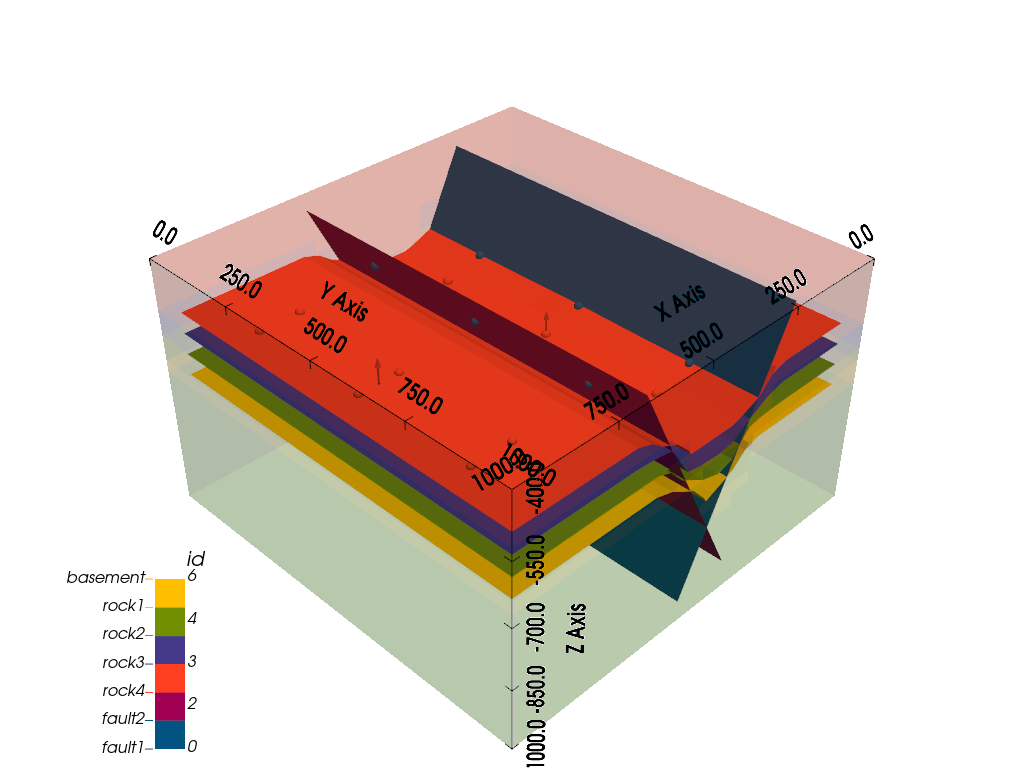

<gempy_viewer.modules.plot_3d.vista.GemPyToVista object at 0x7ff2af877fa0>
gp.add_structural_group(
model=geo_model,
group_index=1,
structural_group_name="fault_series_2",
elements=[fault2],
structural_relation=gp.data.StackRelationType.FAULT,
fault_relations=gp.data.FaultsRelationSpecialCase.OFFSET_ALL
)
print(geo_model.structural_frame)
gp.compute_model(geo_model)
StructuralFrame(
structural_groups=[
StructuralGroup(
name=fault_series_1,
structural_relation=StackRelationType.FAULT,
elements=[
Element(
name=fault1,
color=#015482,
is_active=True
)
]
),
StructuralGroup(
name=fault_series_2,
structural_relation=StackRelationType.FAULT,
elements=[
Element(
name=fault2,
color=#9f0052,
is_active=True
)
]
),
StructuralGroup(
name=default_formation,
structural_relation=StackRelationType.ERODE,
elements=[
Element(
name=rock4,
color=#ff3f20,
is_active=True
),
Element(
name=rock3,
color=#443988,
is_active=True
),
Element(
name=rock2,
color=#728f02,
is_active=True
),
Element(
name=rock1,
color=#ffbe00,
is_active=True
)
]
)
],
fault_relations=
[[False, True, True],
[False, False, True],
[False, False, False]],
Setting Backend To: AvailableBackends.numpy
/home/leguark/TeamCity/work/3a8738c25f60c3c9/venv/lib/python3.10/site-packages/gempy_engine/modules/activator/_soft_segment.py:95: RuntimeWarning: overflow encountered in exp
return 1.0 / (1.0 + bt.t.exp(x))
Chunking done: 7 chunks
Chunking done: 7 chunks
Chunking done: 38 chunks
Chunking done: 7 chunks
Chunking done: 7 chunks
Chunking done: 38 chunks
/home/leguark/TeamCity/work/3a8738c25f60c3c9/venv/lib/python3.10/site-packages/gempy_engine/modules/activator/_soft_segment.py:95: RuntimeWarning: overflow encountered in exp
return 1.0 / (1.0 + bt.t.exp(x))
/home/leguark/TeamCity/work/3a8738c25f60c3c9/venv/lib/python3.10/site-packages/gempy_engine/modules/activator/_soft_segment.py:95: RuntimeWarning: overflow encountered in exp
return 1.0 / (1.0 + bt.t.exp(x))
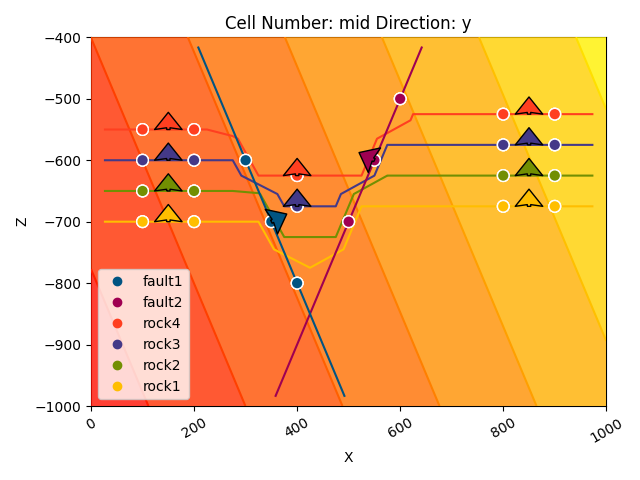

<gempy_viewer.modules.plot_3d.vista.GemPyToVista object at 0x7ff2a5440670>
<gempy_viewer.modules.plot_2d.visualization_2d.Plot2D object at 0x7ff2a53bcbe0>
Finite Faults¶
Faults relations¶
Let’s split the formations in two groups
gp.add_structural_group(
model=geo_model,
group_index=2,
structural_group_name="series_1",
elements=[
geo_model.structural_frame.get_element_by_name("rock4"),
geo_model.structural_frame.get_element_by_name("rock3")
],
structural_relation=gp.data.StackRelationType.ERODE
)
default_group.elements.remove(geo_model.structural_frame.get_element_by_name("rock4"))
default_group.elements.remove(geo_model.structural_frame.get_element_by_name("rock3"))
gp.set_fault_relation(
frame=geo_model.structural_frame,
rel_matrix=np.array([
[0, 1, 1, 1],
[0, 0, 0, 1],
[0, 0, 0, 0],
[0, 0, 0, 0]
]
)
)
print(geo_model.structural_frame)
StructuralFrame(
structural_groups=[
StructuralGroup(
name=fault_series_1,
structural_relation=StackRelationType.FAULT,
elements=[
Element(
name=fault1,
color=#015482,
is_active=True
)
]
),
StructuralGroup(
name=fault_series_2,
structural_relation=StackRelationType.FAULT,
elements=[
Element(
name=fault2,
color=#9f0052,
is_active=True
)
]
),
StructuralGroup(
name=series_1,
structural_relation=StackRelationType.ERODE,
elements=[
Element(
name=rock4,
color=#ff3f20,
is_active=True
),
Element(
name=rock3,
color=#443988,
is_active=True
)
]
),
StructuralGroup(
name=default_formation,
structural_relation=StackRelationType.ERODE,
elements=[
Element(
name=rock2,
color=#728f02,
is_active=True
),
Element(
name=rock1,
color=#ffbe00,
is_active=True
)
]
)
],
fault_relations=
[[False, True, True, True],
[False, False, False, False],
[False, False, False, False],
[False, False, False, False]],
Setting Backend To: AvailableBackends.numpy
/home/leguark/TeamCity/work/3a8738c25f60c3c9/venv/lib/python3.10/site-packages/gempy_engine/modules/activator/_soft_segment.py:95: RuntimeWarning: overflow encountered in exp
return 1.0 / (1.0 + bt.t.exp(x))
Chunking done: 7 chunks
Chunking done: 7 chunks
Chunking done: 23 chunks
Chunking done: 17 chunks
Chunking done: 7 chunks
Chunking done: 7 chunks
Chunking done: 22 chunks
Chunking done: 17 chunks
/home/leguark/TeamCity/work/3a8738c25f60c3c9/venv/lib/python3.10/site-packages/gempy_engine/modules/activator/_soft_segment.py:95: RuntimeWarning: overflow encountered in exp
return 1.0 / (1.0 + bt.t.exp(x))
/home/leguark/TeamCity/work/3a8738c25f60c3c9/venv/lib/python3.10/site-packages/gempy_engine/modules/activator/_soft_segment.py:95: RuntimeWarning: overflow encountered in exp
return 1.0 / (1.0 + bt.t.exp(x))
/home/leguark/TeamCity/work/3a8738c25f60c3c9/venv/lib/python3.10/site-packages/gempy_engine/modules/activator/_soft_segment.py:95: RuntimeWarning: overflow encountered in exp
return 1.0 / (1.0 + bt.t.exp(x))
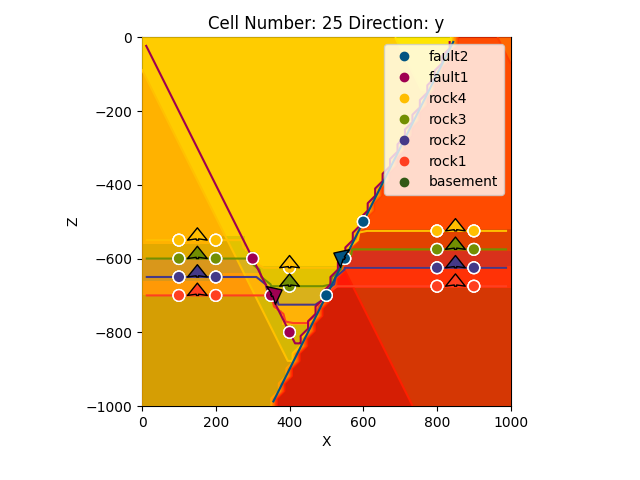

<gempy_viewer.modules.plot_3d.vista.GemPyToVista object at 0x7ff2a55e83d0>
Total running time of the script: (2 minutes 55.261 seconds)
